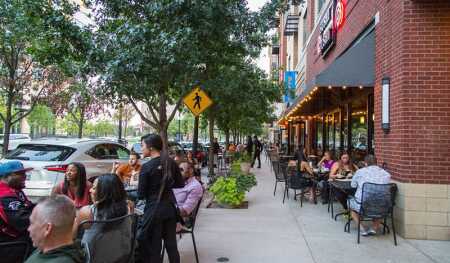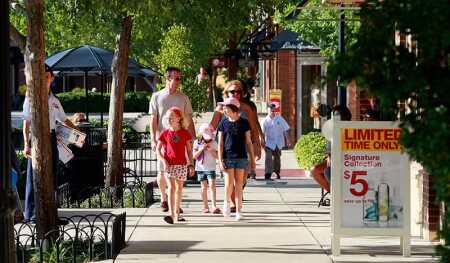While it is estimated that 98 percent of the Dallas/Fort Worth region’s land mass is suburban-style development requiring the day-to-day use of a car, panelists speaking at a recent ULI North Texas event say most of what has been built in the current cycle has favored walkable urban places, whether in the downtown areas or in suburban corridors.
“What we are talking about is a new way of building your city and your region, which is walkable, urban development,” said Christopher Leinberger, professor of urban real estate at the George Washington University School of Business. Leinberger was the keynote speaker at an event hosted by ULI North Texas exploring walkable urbanism in April in Dallas. He also spoke at a similar event in Fort Worth the following day.
“[The data show that you] are a laggard, but there are indications that you are really picking up steam and could move to the front of the queue pretty quickly,” Leinberger said at the event in Dallas.
In his role at George Washington University, Leinberger is working with ULI, the North Central Texas Council of Governments, and a host of other regional entities to complete a census of real estate in Dallas/Fort Worth (DFW).
The survey will divide the real estate between walkable urban developments and suburban drivable developments and examine data that include the value premiums of walkable versus suburban developments, market-share shifts, social equity, gross regional product per capita in the developments, identification of different types of walkable developments, and identification of future walkable development opportunities.
Initial findings show that the number of DFW’s walkable developments has rapidly increased. In 2010, only 10 percent of offices and apartments were in walkable urban developments—a percentage much lower than that seen in the comparable cities of Atlanta and Washington, D.C. In the 2010–2017 real estate cycle, however, DFW produced three times more walkable urban projects than drivable suburban projects. “That’s a really good sign,” Leinberger said.
Although walkable cities are not new—many towns have a history of having developed around a courthouse or municipal square with a central plaza and retail, office, and residential space within walking distance—the United States strayed from that model with the rise of the automobile during the Industrial Age.
While drivable suburban development is a legitimate way to develop, places like Dallas/Fort Worth overdid it, he said. The suburban trend, from the mid-1940s into the early 1990s, included the rise of the regional mall, suburban business parks, and vast freeway systems that cut neighborhoods off from each other.
The pendulum began to swing back toward walkable urbanism during the 1990s, gained more steam in the early 21st century, and now is “roaring,” Leinberger said.
Major metro areas that have had success with walkable urbanism include New York City, D.C., Boston, Seattle, San Francisco, and Minneapolis/St. Paul.
Arlington County, Virginia, was one of the concept’s pioneers after major retailers began to close in the 1980s along its main commercial corridor. At the time, the corridor accounted for 11 percent of Arlington’s land mass and about 20 percent of the tax revenue. Today, that 11 percent of land mass is a vibrant mixed-use, walkable development that accounts for about 55 percent of the tax revenue, Leinberger said.
Walkable Urbanism Works for the Suburbs
“This isn’t just the center city coming back,” Leinberger said. While Dallas has had success redeveloping its downtown and attracting residents to live there, part of the urban trend is occurring in the suburbs. He estimated that 60 to 70 percent of walkable urbanism is happening in the suburbs.
DFW’s sprawling growth gobbled up small farming towns around it such as Grapevine, the oldest town in Tarrant County, founded in 1844. Some of these towns, while being absorbed by suburbia, have also found a way in recent years to revitalize their historic downtowns into walkable urban developments.
Grapevine is one example. Dallas/Fort Worth International Airport opened in 1974, taking up a portion of Grapevine’s land mass for a regional airport that stretches across nearly 30 square miles (78 sq km) and into four city jurisdictions. Later, in 1997, the 1.6 million-square-foot (148,600 sq m) Grapevine Mills Mall with 180 stores would open on the city’s edge. And in 2004, the massive Gaylord Texan Resort & Convention Center opened. Despite the trappings of suburbia, Grapevine has worked over the years to revitalize its quaint downtown Main Street into a walkable mecca.
Others have built walkable urbanism in the region from scratch. Southlake, Texas, a suburban community northeast of Fort Worth, did not have a downtown before Cooper & Stebbins, a California company, bought 130 acres (53 ha) of undeveloped land and proposed creating one. Built to look like a turn-of-the-20th-century downtown, its center is anchored by a town hall that opened in 1999 as part of the development’s first phase. The development attracts large crowds to its retail offerings, restaurants, offices, entertainment uses, main plaza, and townhouses.
Economics Favor Walkable Urbanism
In a study of 30 metro areas, Leinberger said the walkable urban real estate products had a 72 percent price premium on average for rent per square foot. That is also the case for such developments in Dallas, he said.
“We have not reached peak premium, if you will,” Leinberger said. “There is still a lot of pent-up demand.”
The study shows that the six most walkable urban areas in the 30 metro areas have a gross domestic product (GDP) per capita of $72,000 versus the least walkable urban areas, which include Dallas, of $48,000. Dallas was a bit of an anomaly in that its per-capita GDP, at $65,000, was fairly high, but it scored low post–high school educational attainment, which is one driver of demand for walkable urbanism.
Leinberger said that the market share of walkable development is expanding throughout the country, including in Dallas/Fort Worth, and he expects that to continue.
The summit included a panel discussion with Don Day, a developer who has spearheaded development in downtown McKinney, Texas; Bill Flaherty of Rosewood Property Co., which is in the beginning phases of developing a walkable development in Plano, Texas; Neal Sleeper, who is known for his pioneering walkable developments in Uptown; and Kourtny Garrett; who heads up Downtown Inc., an advocate for the city core and its surrounding neighborhoods.






